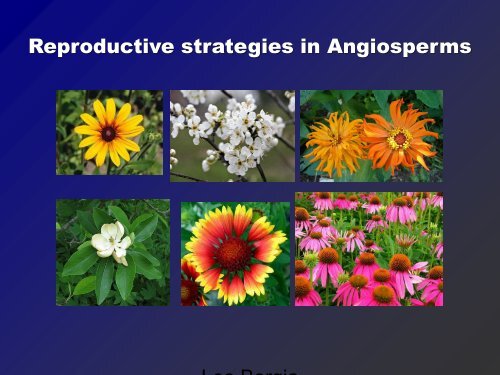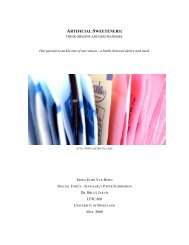Reproductive strategies in Angiosperms
Reproductive strategies in Angiosperms
Reproductive strategies in Angiosperms
You also want an ePaper? Increase the reach of your titles
YUMPU automatically turns print PDFs into web optimized ePapers that Google loves.
<strong>Reproductive</strong> <strong>strategies</strong> <strong>in</strong> <strong>Angiosperms</strong>
Overview<br />
●<br />
●<br />
●<br />
●<br />
Self Incompatibility and changes <strong>in</strong> a mat<strong>in</strong>g<br />
system<br />
Types of mixed reproduction <strong>strategies</strong><br />
Obligate apomicts<br />
How plants enforce outcross<strong>in</strong>g
Mechanisms to promote<br />
Outcross<strong>in</strong>g<br />
●<br />
●<br />
●<br />
●<br />
Dioecy – separation of sexes between<br />
<strong>in</strong>dividual plants, not hermaphrodite.<br />
Self <strong>in</strong>compatibility – sometimes too effective<br />
Dichogamy – Male and Female reproductive<br />
parts mature asynchronously<br />
Herkogamy – Spatial separation of sex parts
Arabidopsis Lyrata<br />
●<br />
●<br />
●<br />
●<br />
Normally a genetically SI obligate outcrosser<br />
Shift <strong>in</strong> mat<strong>in</strong>g system resulted <strong>in</strong> loss of<br />
heterozygosity<br />
Low population density and poll<strong>in</strong>ator scarcity drive<br />
loss of SI system<br />
SI will evolve with high <strong>in</strong>breed<strong>in</strong>g depression
Why mixed reproduction?<br />
●<br />
●<br />
●<br />
●<br />
Perennials have more opportunities to outcross<br />
Resource allocation depends on environment<br />
Most species are hermaphroditic<br />
High seed set versus Inbreed<strong>in</strong>g depression
Viola lanceolata<br />
●<br />
●<br />
●<br />
●<br />
Mixed breed<strong>in</strong>g with two flower types<br />
Either Outcross<strong>in</strong>g chasmogamous flowers or<br />
self<strong>in</strong>g cleistogamous flowers<br />
Tradeoff between two types<br />
Chasmogamy results from favorable<br />
(Cortes 2006)<br />
environmental factors.
Bulb<strong>in</strong>e vagans<br />
●<br />
●<br />
●<br />
●<br />
●<br />
Hermaphroditic flowers accessible to bees<br />
Spatial separation of pistils and stamens<br />
Sex parts fold together when flower expires<br />
Inbreed<strong>in</strong>g depression observed<br />
<strong>Reproductive</strong> assurance without wast<strong>in</strong>g ovules<br />
(Vaughton 2007)
Evidence of Inbreed<strong>in</strong>g Depression
Taraxacum offic<strong>in</strong>ale<br />
●<br />
●<br />
●<br />
●<br />
Polyploid Amomicts<br />
Clonal reproduction results <strong>in</strong> highly<br />
homogeneous communities.<br />
Numerous hybridization events<br />
Asexual offspr<strong>in</strong>g from sexual parents<br />
(Majesky 2012)
Conclusion<br />
●<br />
●<br />
●<br />
●<br />
Both autogamy or self <strong>in</strong>compatibility will evolve<br />
under certa<strong>in</strong> conditions.<br />
Costs associated with reproduc<strong>in</strong>g sexually<br />
Mixed reproduction can be accomplished<br />
different ways.<br />
Asexual species arise from hybridization
Works Cited<br />
Majeský L, Vasut RJ, Kitner M, Trávnícek B. The pattern of genetic variability <strong>in</strong> apomictic clones of taraxacum offic<strong>in</strong>ale <strong>in</strong>dicates the<br />
alternation of asexual and sexual histories of apomicts. PLoS One. 2012;7(8).<br />
Aurea CC, Ballard,Harvey E.,,Jr. Influence of annual fluctuations <strong>in</strong> environmental conditions on chasmogamous flower production <strong>in</strong> viola<br />
striata1. J Torrey Bot Soc. 2006;133(2):312-320.<br />
Mable BK, Robertson AV, Dart S, Berardo CD, Witham L. Breakdown of self-<strong>in</strong>compatibility <strong>in</strong> the perennial ArabidopsisLyrata (brassicaceae)<br />
and its genetic consequences. Evolution. 2005;59(7):1437-1448. http://search.proquest.com/docview/55590502?accountid=14696. doi:<br />
http://dx.doi.org/10.1043/0014-3820(2005)059[1437:BOSITP]2.0.CO;2.<br />
Porcher E, Lande R. Loss of gametophytic self-<strong>in</strong>compatibility with evolution ofInbreed<strong>in</strong>g depression. Evolution. 2005;59(1):46-60.<br />
http://search.proquest.com/docview/55697690?accountid=14696. doi: 2.0.CO;2" TARGET="_blank">http://dx.doi.org/10.1043/0014-<br />
3820(2005)0592.0.CO;2<br />
Vaughton G, Ramsey M, Simpson I. Does self<strong>in</strong>g provide reproductive assurance <strong>in</strong> the perennial herb bulb<strong>in</strong>e vagans (asphodelaceae)? Oikos.<br />
2008;117(3):390-398. http://search.proquest.com/docview/211499354?accountid=14696. doi: http://dx.doi.org/10.1111/j.2007.0030-<br />
1299.16365.x. .




